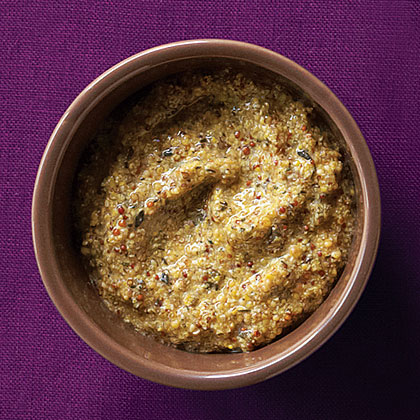Rosemary Thyme Mustard

How to Make It
Stir together mustard seeds, 2 tsp. thyme, the rosemary, 1/3 cup water, and the vinegar in a bowl until seeds are submerged. Let sit at room temperature, covered, 2 to 3 days.
Put mustard mixture in a blender along with brown sugar and salt and blend until mixture is thick but still coarse-textured. Stir in remaining 1 tsp. thyme.
Make ahead: 2 weeks, covered and chilled.
Custom Mustard
Your imagination's the limit when it comes to making flavored mustard. All you need are mustard seeds or dry mustard powder, and then the seasonings are up to you.
Mustard seeds or mustard powder?
Either works.
Mustard seeds: Use when you want a whole-grain, crunchy texture. The three types are yellow, aka white (Sinapis alba), the mildest and used mainly in American-style mustards and for pickling; brown (Brassica juncea), zestier and used in European-style mustards (like Dijon), for pickling, and in Indian cooking; and black (B. nigra), also used in Indian food; they're interchangeable with the brown. Seeds need to soften in liquid for 1 to 2 days before you make mustard with them.
Mustard powder: For silky smooth mustard. It's nothing more than ground mustard seed, and the most common brand is Colman's, a blend of white and brown seeds. Mix the powder with liquid (like water or beer) and let it sit overnight to fully hydrate and develop flavor. Don't let it sit longer, though, or it will taste harsh.
Ingredients
Directions
Stir together mustard seeds, 2 tsp. thyme, the rosemary, 1/3 cup water, and the vinegar in a bowl until seeds are submerged. Let sit at room temperature, covered, 2 to 3 days.
Put mustard mixture in a blender along with brown sugar and salt and blend until mixture is thick but still coarse-textured. Stir in remaining 1 tsp. thyme.
Make ahead: 2 weeks, covered and chilled.
Custom Mustard
Your imagination's the limit when it comes to making flavored mustard. All you need are mustard seeds or dry mustard powder, and then the seasonings are up to you.
Mustard seeds or mustard powder?
Either works.
Mustard seeds: Use when you want a whole-grain, crunchy texture. The three types are yellow, aka white (Sinapis alba), the mildest and used mainly in American-style mustards and for pickling; brown (Brassica juncea), zestier and used in European-style mustards (like Dijon), for pickling, and in Indian cooking; and black (B. nigra), also used in Indian food; they're interchangeable with the brown. Seeds need to soften in liquid for 1 to 2 days before you make mustard with them.
Mustard powder: For silky smooth mustard. It's nothing more than ground mustard seed, and the most common brand is Colman's, a blend of white and brown seeds. Mix the powder with liquid (like water or beer) and let it sit overnight to fully hydrate and develop flavor. Don't let it sit longer, though, or it will taste harsh.

